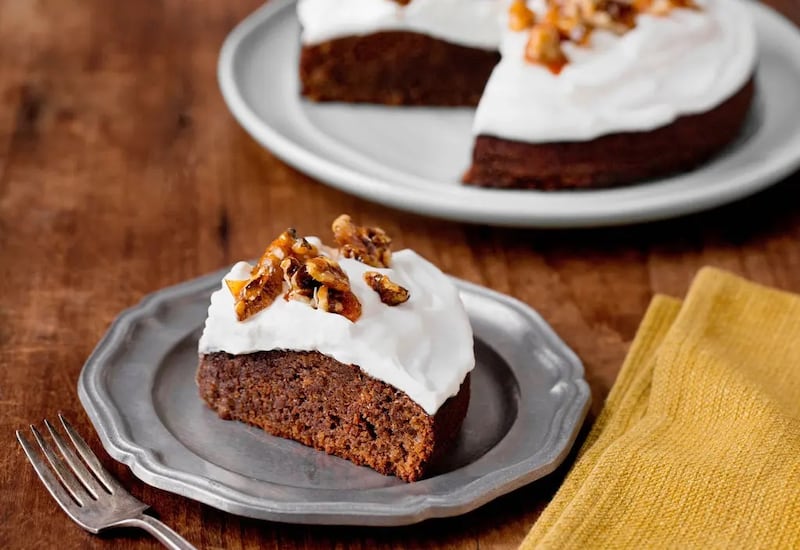This recipe test was a really educational experience for me, as I haven’t done much gluten-free baking. Gluten (commonly found in wheat flour) is a crucial component in baking, so it’s really interesting to try to replace it with substitutes: here I’ve tested six different recipes using a combination of gluten-free flours, nuts, polenta and cocoa, to varying degrees of success. I tested recipes by Jamie Oliver, Nigella Lawson, Genevieve Ko, David Tanis, Yotam Ottolenghi and Felicity Cloake to figure out which substitutes work best.
Why is gluten useful in baking?
Gluten is a protein found in many grains such as wheat, rye and barley. More specifically, these grains contain glutenin and gliadin, which form gluten when combined with water. Most types of wheat flour contain gluten-forming protein at levels varying between 8 per cent and 14 per cent, with soft or cake/pastry flour at the lower end of the scale and strong or bread flour at the higher end. Gluten is formed when liquid is added to flour, and can be developed further by mixing or kneading. In bread, this gluten helps to trap gas bubbles, leading to more air and a higher rise. In cakes and pastry, it’s more common to use a lighter hand when mixing, to avoid overworking the gluten as the desired result is usually a more tender crumb – and for this reason, softer flours with a lower protein content are usually used.
Gluten intolerance and coeliac disease
Coeliac disease is an autoimmune condition where the immune system attacks its own tissues when gluten is ingested, causing damage to the lining of the small intestine (gut) and meaning that the body cannot absorb nutrients. It also causes a range of gastrointestinal symptoms. About 1 per cent of people globally have coeliac disease, and many more are affected by an intolerance to gluten.

Mixing method
The methods for making these cakes are not dissimilar to those you would use for cakes containing gluten. Jamie Oliver and Nigella Lawson use a creaming method for theirs, while David Tanis, Yotam Ottolenghi and Felicity Cloake use a kind of sponge method where the yolks and whites are whisked separately before being combined with the other ingredients. Genevieve Ko’s cake is more similar to a brownie, and the method is fairly straightforward: the chocolate and butter are melted together, then the rest of the ingredients are added one at a time.
READ MORE
Gluten substitutes
When it comes to substituting ingredients for gluten, there are several options. There are gluten-free flour blends available which usually involve ingredients such as rice, potato, tapioca, maize and buckwheat. Jamie Oliver’s recipe uses a gluten-free flour blend, and I used the Dove’s Farm option which is widely available in health food shops and supermarkets. This type of flour can be used as a straight swap for wheat flour, but may not react in exactly the same way, depending on the recipe. Binding agents such as xanthan gum or psyllium husk are often used to help with the structure of gluten-free bakes. Baking soda can be used as normal, but it’s important to check that the baking powder you’re using is gluten free, as many companies include wheat flour as a bulking agent. It’s relatively easy to find gluten-free options, though, which use cornflour or potato starch instead.
My personal preference is for cakes that use grains or nuts, instead of gluten-free flour blends. I don’t like the texture of many of the gluten-free flour blends on the market, and I find that nuts or grains such as polenta provide a much more interesting result, without the need for artificial additives or binding agents. I find that it’s best to start with a recipe that doesn’t require much gluten to begin with, so that the substitute doesn’t have to work too much: for example, Genevieve Ko’s recipe is very similar to a brownie, which is low in flour anyway, so the cocoa can fulfil the same purpose, and actually contribute to the flavour and texture of the bake.
For this recipe, I’ve used a combination of walnuts (ground into coarse meal) and almonds, with a small amount of gluten-free flour (Dove’s Farm in this case) to help bind the cake. It’s slightly denser than a cake that contains gluten, but I find that the nuts bring so much to the flavour and texture that you wouldn’t even miss the gluten. I’ve gone all in with the chocolate and nuts, including chocolate chips in the cake batter and covering the whole cake with a dark chocolate and walnut “rocher”, making this cake perfect for a celebration or an afternoon tea treat.
Beth’s gluten-free walnut and chocolate cake
References:













